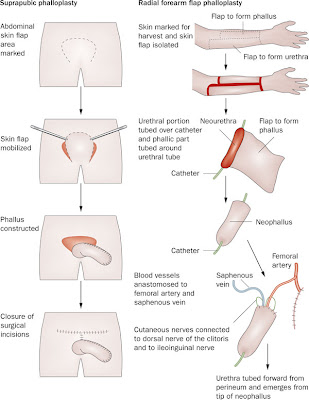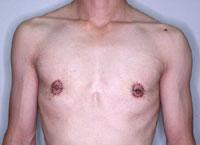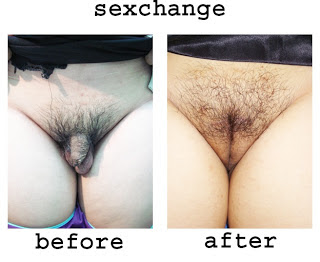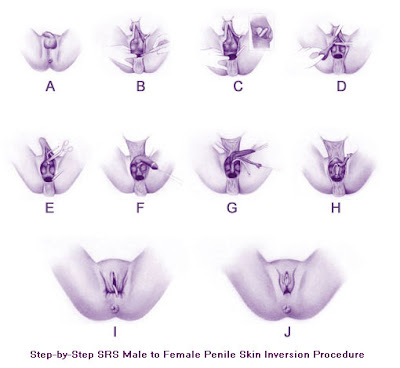Dear Blog Readers, I just found this article on sex reassignment pictures, here are some photos of before and after sex change surgery , sex reassignment and sex change operation from female to male and male to female as well as some homosexual sex surgery and here are some more pictures of before and after transsexual surgery. During sex change surgery operation in the operation theater, the picture clearly shows that how they can proceed right from the initial steps in vagina, implanting penis and after the penis implantation pictures.
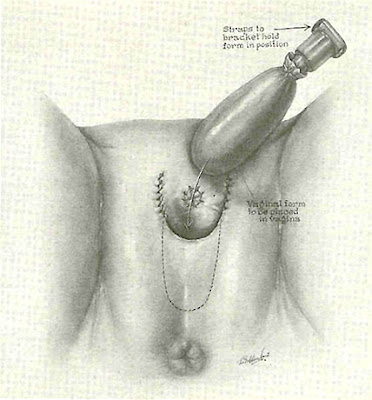 | |
| sex change surgery photos |
Below, there are real pictures of sex change surgery (SRS) male to female transsexual picture that I actually took from some other sources in terms of my blog viewers to make them graceful while they are desperately looking for information and how does it look like after the vagine converted into real penis, some also asked about do they still able to release sperm. Well, for this reason I am still researching to gain more genuine information and will be posting shortly. Now what they have been expecting to find out about sex change surgery either sex change surgery from male to female or female to male by transsexual surgery operation.
I got this info page from http://www.symposion.com/ and I thought it would be helpful to my visitors who're here looking for information and pictures of sex change surgery. So I made it my blog post.
Beginnings
of Sex Reassignment Surgery in Japan
By Takamatsu Ako, M.D., Harashina Takao, M.D., Inoue Yoshiharu, M.D., Kinoshita Katsuyuki, M.D.**, Ishihara Osamu, M.D.**, Uchijima Yutaka, M.D.* **Department of Plastic and Reconstructive Surgery, Gynecology*, Urology**, Saitama Medical Center, Saitama Medical School, Japan Abstract
The first sex reassignment surgery (SRS) performed officially in Japan
- for a female-to-male (FtM) person in 1998 and for a male-to-female (MtF)
person in 1999 - are reported. For the FtM, two-stage conversion was applied.
In the first operation, salpingo-oophorectomy, hysterectomy, colpectomy,
metoidioplasty, and mastectomy were performed. A free flap phalloplasty with
the deltoid flap is planned as the second stage. For the MtF, one-stage neovaginoplasty was performed by penile skin inversion technique with sensate pedicled neoclitoplasty.
|
||||||||||||
Introduction
Japan, which is considered to be one of the world's
most advanced countries in terms of its economy, technology, industry, and
medicine, has long been in the dark ages regarding people who suffer from
gender dysphoria. In July 1996, the Ethics Committee of Saitama Medical
School submitted a report, at our request, on surgical treatment for
transsexual patients. The report acknowledges that transsexualism exists and
that treating transsexual patients can be regarded as a justifiable medical
activity. The report was made public by mass media. In 1997, the medical
guidelines for transgender persons were issued by the Japanese Society of
Psychiatry and Neurology, with some modifications of the Standards of Care of
the Harry Benjamin International Gender Dysphoria Association. We organized a
medical team composed of psychiatrists, a sexologist, endocrinologists,
gynecologists, urologists, and plastic surgeons.
This is a report of the first sex reassignment
surgeries (SRSs) officially performed in Japan: one for a FtM person in 1998
and one for a MtF person in 1999. Diagnosis, preparatory psychotherapy, and
hormonal therapy were carried out according to the above-mentioned
guidelines.
Methods
SRS for a Female-to-Male
Transsexual
In the first operation, regarded as
the first stage in the two-stage conversion, bilateral salpingo-oophorectomy,
hysterectomy, colpectomy, metoidioplasty, and mastectomy were performed. Please click on the picture to enlarge how they perform female to male gender change surgery.
First, the gynecologists performed a transabdominal
oophoro-hysterectomy. Then they began to elevate the anterior vaginal flap
through the abdominal approach. The elevation was completed transvaginally,
just to the dorsal part of the urethral orifice, by plastic surgeons. The
vaginal mucosa was resected, and colpocleisis was accomplished. After the
abdominal wall was closed, we performed a metoidioplasty, as advocated by
Hage (1996). By resection of the chordee, the clitoral shaft was released and
abdominally advanced. The neourethra was constructed by suturing the
vestibular skin, the vaginal mucosal flap and the labial flap around the
urethral catheter in a watertight fashion (Figures 1, 2). A suprapubic
cystostomy was performed and the urethral catheter was removed.
Figure 1 Figure 2
For the bilateral mastectomy, we used a modification
of the concentric-circle periareoral de-epithelization technique reported by
Davidson (1979). Resection of the breast gland and reduction of the nipple
were performed by the transareolar approach described by Pitanguy (1966) and
Hage and Bloem (1995) (Figures 3, 4).Figure 3 Figure 4
see more picture hereThe estimated blood loss was 740 ml, and the total operating time was 6 hours. The postoperative course was completely uneventful. The suprapubic catheter was left in place for 7 days. The total hospital stay was 14 days.We are planning a free-flap phalloplasty as the second stage of the conversion. The patient desires the phalloplasty but at this time cannot afford the necessary fee which will amount to 2,500,000 yen (US$25,000). SRS for a Male-to-Female Transsexual A one-stage operation was performed in June 1999. The operative technique involved the following procedures: bilateral orchiectomy and penectomy followed by vaginoplasty, clitoroplasty, and vulvoplasty. For the vaginoplasty, we employed a modification of the abdominally pedicled penile-skin-inversion technique added by a triangular perineal skin flap (Karim, Hage and Mulder, 1996). A dorsally based triangular perineal flap measuring about 10 cm long and 4 cm wide was used to line the posterior wall of the neovagina and widen the introitus (Figure 5). The testes were isolated and then removed with a double ligation of the spermatic cord at the level of the external inguinal rings. The skin of the penile shaft was mobilized from the corpora up to the level of the corona. A circumcising skin incision was made at the corona, completely denuding the penis of its skin and leaving the glans penis attached to the corpora. in figure 5 its shows that after cutting the penis off and converted into the vagina as we seen in the pictures. It seems very real and not much difference if you see on the before and after sex change photo.
Figure 6 The dorsal part of the glans penis was used as a clitoris. Sensate pedicled neoclitoplasty using the reduced glans, which remained attached to its dorsal penile neurovascular pedicle, was performed (Brown, 1976). The corpora cavernosa were resected to prevent postoperative pain due to erection of the remaining corpora tissues. A neovaginal cavity was created by dissection between the two layers of Denonvillier's fascia using a laparoscope placed in the abdomen as a guide. The created neovaginal depth was approximately 10 cm.
The estimated blood loss was 760 ml and no transfusion was necessary. The postoperative course was uneventful and the patient was discharged on the eighth postoperative day. She wore the dilating stent every day for 3 months postoperatively; nevertheless, the neovagina decreased in depth to 6 cm and in diameter to two fingers' width. The neoclitoris was found to have returned to a normal level of sensation (Figure 8). The patient has returned to her previous occupation. Discussion We believe that most FtM transsexuals desire closure of the vagina. However, we recognize the different view of some surgeons who consider the risk benefit to be rather high. Their reasoning is that most patients are not necessarily aware of the presence of the vagina because of decreased discharge after hysterectomy and atrophied mucosa due to long-term hormone therapy. We have found vaginectomy to be technically difficult and bloody and autotransfusion has a valuable place here. We have also found the vaginas of the Japanese FtM transsexuals we have examined to be very narrow compared with those we have observed elsewhere, so we have chosen to do transabdominal hysterectomies. The other advantage of the transabdominal approach is that the partial elevation of a sufficient size of the anterior vaginal flap and vaginectomy can be carried out from above, under direct vision.
In SRS for MtF transsexuals, we employed a
laparoscope to assist in dissecting the vaginal cavity. Its light can help
avoid injury to the prostate and rectum and can provide a direct view of the
vaginal cavity up to the peritoneum.
We are planning a free-flap phalloplasty as the second stage of the FtM SRS (Figure 10). We have experienced 13 cases of deltoid flap and 5 cases of forearm-flap phalloplasties in non- transsexual patients during the past 15 years (Figure 11). These techniques always result in extensive scarring of the donor area. Our first choice of donor site for phallic construction is the deltoid flap (Harashina et al.,1990) because it results in less morbidity in the donor site, is a true sensory flap, has hairless skin, and is less likely to result in atrophy of the neophallus. However, this technique may be technically more difficult than that with the forearm flap, and it may be impossible to make a roll on obese patients. We think the deltoid flap is especially suitable for Japanese FtM patients because they generally are not obese. In fact, they usually try to reduce their weight so that they will not be regarded as females. At the time of writing this paper, we have performed six SRSs: one for MtF and five for FtM. Four of the five FtM patients had already undergone mastectomies elsewhere. The SRSs were performed at the Gender Clinic of Saitama Medical Center, which was the only provider of transgender-specific health services in Japan as of March 2000. In total, over 400 clients have visited our clinic since the first patient arrived in 1992, and about 100 new gender dysphoric clients have been seen each year. Sixty percent of them seek SRS. While there are many candidates, we take our time before performing surgery because there are very few psychiatric specialists in this field in Japan and we must apply for permission from our ethics committee in each case. Conclusion The first SRS operation in Japan was affirmatively reported all over the country and there was actually no public criticism. The operation was an historic turning point for the proper understanding of Gender Identity Disorder in our country. We are just on the starting line. Many issues remain to be resolved in promoting the welfare of our patients. Whereas public interest is steadily increasing and some acknowledgement of SRS seems to have become established, there is still no policy regarding health insurance and legislation for those who have undergone the procedure. SRS is not covered by National Health Insurance, and postoperative persons cannot yet change any of their documents. Our team is still the only practising gender surgery team in Japan, although two other teams are now being organized. Despite these difficulties, the role of SRS, performed justifiably, is becoming more prominent in the treatment of transsexualism in Japan. Do not forget to comment below, We need your valuable information in relation to sex change operation or SRS surgery. I encourage to all the readers to share their stories and experiences. Remember ! "Sharing is Caring". References Brown, J. (1976) Creation of a functional clitoris and aesthetically pleasing introitus in sex conversion. In Marchac, D. (Ed.), Transactions of the 6th International Congress of Plastic and Reconstructive Surgery. Paris: Masson, pp. 654-655. Davidson, B. A. (1979) Concentric circle operation for massive gynecomastia to excise the redundant skin. Plastic and Reconstructive Surgery, 63: 350-354. Hage, J.J. (1996) Metoidioplasty: An alternative phalloplasty technique in transsexuals. Plastic and Reconstructive Surgery, 97: 161-167. Hage, J. J., Bloem J.J.A.M. (1995) Chest wall contouring for female-to-male transsexuals: Amsterdam experience. Annals of Plastic Surgery, 34: 59-66. Harashina T., Inoue T., et al. (1990) Reconstruction of penis with free deltoid flap. British Journal of Plastic Surgery, 43: 217-222. Karim, R.B., Hage J. J., and Mulder J. W. (1996) Neovaginoplasty in male transsexuals: Review of surgical techniques and recommendations regarding their eligibility. Annals of Plastic Surgery, 37: 669-675. Pitanguy, I. (1966) Transareolar incision for gynecomastia. Plastic and Reconstructive Surgery, 38: 414-419. Acknowledgement We are very much grateful to Doctor Joris J. Hage in the Netherlands for his valuable help in order to accomplishing this task. |










